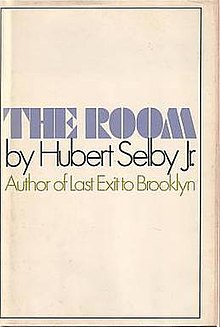The Room (novel)
 First edition | |
| Author | Hubert Selby Jr. |
|---|---|
| Language | English |
| Genre | Modern tragedy, stream of consciousness |
| Publisher | Grove Press |
Publication date | 1971 |
| Publication place | United States |
| Media type | |
| Pages | 288 |
| Preceded by | Last Exit to Brooklyn |
| Followed by | The Demon |
The Room is the second novel by Hubert Selby Jr., first published in 1971.
Plot
[edit]The novel centers on a nameless petty criminal locked in a remand cell awaiting trial for a crime only vaguely defined. As the novel progresses the man surrenders himself to self-pity and hatred, constructing elaborate fantasies of revenge and the torture he wishes to inflict on the officers who, he believes, falsely arrested him.
Reception
[edit]Selby described the critical reception of the book as "the greatest reviews I've ever read in my life", although in reality it was not well received.[1][2] The novel was regarded by Selby as the most disturbing book ever written, and Selby stated that he himself was unable to read it again for 20 years.[2] At least one reviewer has expressed similar feelings, with claims that reading the novel made him physically sick.[3] It has been described as "a terrifying journey into the darkest corners of the psyche."[4]
In popular culture
[edit]A section of The Room is used in Richard Linklater's Waking Life, where a red-faced man in a jail cell describes in vivid detail the abuse he intends to inflict once he is released.[5]
The 2008 death metal track "Beg, You Dogs" by the band Benediction is based on the book.
References
[edit]- ^ "World on the fringes of writer Selby", BBC
- ^ a b Guttridge, Peter (2004) "Obituaries: Hubert Selby Jnr", The Independent
- ^ Mitchell, Chris "Hubert Selby: The Movie and The Room", Splinter Magazine
- ^ O'Neill, Tony (2007) "A genuinely frightening American Psycho", The Guardian
- ^ Selby Hubert (1971) The Room
